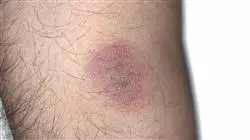University certificate
The world's largest faculty of medicine”
Introduction to the Program
Learn more about the latest developments in the field of proteomics and massive sequencing with this Professional master’s degree”

This Professional master’s degree in Tuberculosis is aimed at healthcare professionals in charge of the diagnosis, treatment and prevention of infections who wish to intensively address the most up-to-date and extensive knowledge of this infectious disease with the main objective of incorporating it into their usual clinical practice.
During this 12-month program, i.e., 1,500 teaching hours, professionals will delve into the relevant factors in managing these clinical pictures and the recent diagnostic tools used, as well as the latest developments in the treatment of infections caused by this group of microorganisms.
Also, the specialized team with extensive experience in Microbiology in leading hospitals in this area of medicine, will teach students the latest scientific advances achieved for the management of Tuberculosis and other infections in special populations whose approach requires extensive knowledge as in the case of pediatric patients, HIV patients, transplanted or immunocompromised.
An opportunity to update knowledge, while balancing personal and professional responsibilities in a 100% online program. Students will be able to access all the content at any time of the day, as there are no sessions with fixed schedules, they will only need a device with an Internet connection that allows them to view the entire syllabus, as well as the video summaries, essential specialized readings and the practical cases proposed by the teaching team.
Apply the latest scientifically proven treatments to treat Tuberculosis thanks to this online teaching"
This Professional master’s degree in Tuberculosis contains the most complete and up-to-date scientific program on the market. The most important features include:
- The development of practical cases presented by experts in Tuberculosis and Infectious Diseases
- The graphic, schematic, and practical contents with which they are created, provide scientific and practical information on the disciplines that are essential for professional practice
- Practical exercises where the self-assessment process can be carried out to improve learning
- Its special emphasis on innovative methodologies
- Theoretical lessons, questions to the expert, debate forums on controversial topics, and individual reflection assignments
- Content that is accessible from any fixed or portable device with an Internet connection
Access recent advances in non-tuberculous mycobacterial infections in immunocompromised patients”
The program’s teaching staff includes professionals from the sector who contribute their work experience to this educational program, as well as renowned specialists from leading societies and prestigious universities.
The multimedia content, developed with the latest educational technology, will provide the professional with situated and contextual learning, i.e., a simulated environment that will provide immersive education programmed to learn in real situations.
This program is designed around Problem-Based Learning, whereby the professional must try to solve the different professional practice situations that arise throughout the program. This will be done with the help of an innovative system of interactive videos made by renowned experts.
Learn about the latest advances in the treatment of latent Tuberculosis infection in HIV patients"

Update your knowledge to establish the best diagnostic method available for each patient"
Syllabus
This Professional master’s degree has been developed by a teaching team specialized in infectious diseases who belong to different disciplinary fields. Infectious diseases are a constant challenge for professionals involved in their diagnosis and treatment, therefore, throughout the 10 modules into which this study plan has been divided, students will delve and update the essential knowledge for an optimal approach to mycobacterial infections. All this will allow the medical professional to be able to prescribe according to the type of microorganism involved, the sensitivity studies carried out and to offer the most effective treatment depending on the patient being treated.

The simulations of real cases will allow you to learn more about the treatments used for Tuberculosis and other mycobacteria"
Module 1. Mycobacterial Infections
1.1. Evolution
1.2. Current Problems
1.3. Characteristics of Mycobacterium Genus
1.3.1. Composition
1.3.2. Growth and Pigmentation
1.3.3. Pathogenic Character
1.4. Mycobacteria Classification
1.5. Epidemiology
1.5.1. Reservoirs
1.5.2. Transmission Mechanisms
1.6. Pathogenic Mechanisms
1.7. Clinical Forms
1.7.1. Mycobacterium Tuberculosis Complex
1.7.2. Non-Tuberculous Mycobacterias
1.8. Prevention and Control Measures
1.8.1. Chemoprophylaxis
1.8.2. Vaccines
1.9. Biological Safety and Mycobacterias
Module 2. Mycobacterial Infection Diagnosis
2.1. Clinical Suspicion
2.1.1. Sample Collection
2.2. Tuberculin Test
2.2.1. Booster Effect
2.2.2. Inconveniences
2.3. Diagnosis by IGRA
2.3.1. Commercial Systems
2.3.2. Advantages and Disadvantages
2.4. Microscopy
2.4.1. Conventional Stains
2.4.2. Stains for Fluorescence Microscopy
2.5. Culture
2.5.1. Pre-Treatment Phase
2.5.2. Cultivation in Solid Media
2.5.3. Cultivation in Liquid Media
2.5.4. Cultures in Automated Systems
2.6. Phenotypic Identification Techniques
2.6.1. Microscopy and Morphology
2.6.2. Biochemical Tests
2.7. Molecular Identification Techniques
2.7.1. Types
2.7.2. On Direct Sampling
2.7.3. On Colony Grown in Cultures
2.8. Others Diagnostic Methods
2.8.1. Chromatographic Identification
2.8.2. Immunochromatography
2.9. Maldi-TOF in Identifying Mycobacteria
2.10. Diagnostic Imaging
Module 3. Medication and Treatments for Mycobacterial Infections
3.1. Bacterial Populations to be Treated
3.2. Bactericidal Antibiotics
3.2.1. Isoniazid
3.2.2. Rifampicin
3.2.3. Ethambutol
3.2.4. Streptomycin
3.3. Sterilizing Antibiotics
3.3.1. Pyrazinamide
3.3.2. Rifampicin
3.4. Second-Line Antibiotics
3.4.1. Aminoglycosides
3.4.2. Fluoroquinolones
3.4.3. PAS
3.5. New Antibiotics
3.5.1. Linezolid
3.5.2. Levofloxacin
3.5.3. Others
3.6. Treatment Guidelines
3.6.1. Tuberculous Infections
3.6.2. Infections from Other Mycobacteria
3.7. Sensitivity Studies in Mycobacteria
3.7.1. Indications
3.7.2. Proportion Technique
3.8. Sensitivity Studies in Liquid Media
3.9. Sensitivity Studies using Molecular Techniques
3.10. Antibiotic Resistance and its Impact on Treating Mycobacterial Infections
Module 4. Infections caused by Mycobacterium Tuberculosis Complex
4.1. Natural Evolution of the Disease
4.1.1. Immunopathology
4.2. Pathogenesis
4.3. Clinical Manifestations
4.3.1. Diagnostic Criteria
4.4. Pulmonary Tuberculosis
4.4.1. Primary Pulmonary Tuberculosis
4.4.2. Post-Primary Pulmonary Tuberculosis
4.4.3. Tuberculous Pleuritis
4.5. Miliary Tuberculosis
4.6. Genitourinary Tuberculosis
4.7. Osteoarticular Tuberculosis
4.8. Intestinal Tuberculosis and Peritonitis
4.9. Other Forms of Extrapulmonary Tuberculosis
4.10. Treatment Guidelines
Module 5. Infections by Non-Tuberculous Mycobacteria
5.1. Evolution
5.2. Current Problems
5.3. Mycobacterium Avium Complex
5.3.1. Species included in the Complex
5.3.2. Microbiological Characteristics
5.3.3. Clinical Picture
5.3.4. Treatment
5.4. Mycobacterium Kansasii
5.4.1. Microbiological Characteristics
5.4.2. Clinical Picture
5.4.3. Treatment
5.5. Mycobacterium Ulcerans
5.5.1. Microbiological Characteristics
5.5.2. Clinical Picture
5.3.3. Treatment
5.6. Mycobacterium Genavense
5.6.1. Microbiological Characteristics
5.6.2. Clinical Picture
5.6.3. Treatment
5.7. Mycobacterium Haemophilum
5.7.1. Microbiological Characteristics
5.7.2. Clinical Picture
5.7.3. Treatment
5.8. Mycobacterium Marinum
5.8.1. Microbiological Characteristics
5.8.2. Clinical Picture
5.8.3. Treatment
5.9. Mycobacterium Scrofulaceum
5.9.1. Microbiological Characteristics
5.9.2. Clinical Picture
5.9.3. Treatment
5.10. Mycobacterium Gordonae
5.10.1. Microbiological Characteristics
5.10.2. Clinical Picture
5.10.3. Treatment
Module 6. Other Infections by Non-Tuberculous Mycobacteria
6.1. Evolution
6.2. Current Problems
6.3. Mycobacterium Abscesses
6.3.1. Microbiological Characteristics
6.3.2. Clinical Picture
6.3.3. Diagnosis and Treatment
6.4. Mycobacterium Chelonae
6.4.1. Microbiological Characteristics
6.4.2. Clinical Picture
6.4.3. Diagnosis and Treatment
6.5. Mycobacterium Fortuitum Complex
6.5.1. Microbiological Characteristics
6.5.2. Clinical Picture
6.5.3. Diagnosis and Treatment
6.6. Mycobacterium Malmoense
6.6.1. Microbiological Characteristics
6.6.2. Clinical Picture
6.6.3. Diagnosis and Treatment
6.7. Mycobacterium Simiae
6.7.1. Microbiological Characteristics
6.7.2. Clinical Picture
6.7.3. Diagnosis and Treatment
6.8. Mycobacterium Szulgai
6.8.1. Microbiological Characteristics
6.8.2. Clinical Picture
6.8.3. Treatment
6.9. Mycobacterium Xenopi
6.9.1. Microbiological Characteristics
6.9.2. Clinical Picture
6.9.3. Treatment
6.10. Other Non-Tuberculous Mycobacteria
Module 7. Mycobacterial Infections in VIH Patients
7.1. Epidemiology of TB/HIV Co-Infection
7.2. Pulmonary Tuberculosis in HIV-Infected Patients with >200 LTCD4
7.3. Extrapulmonary Tuberculosis in HIV-Infected Patients with >200 LTCD4
7.4. Tuberculosis in HIV-Infected Patients with <200 LTCD4
7.5. Tuberculous Meningitis
7.6. Atypical Mycobacterial Infections in VIH Patients
7.7. Diagnosis of Mycobacterial Infection in HIV Patients
7.8. Treatment of Tuberculosis in HIV Patients
7.9. Treatment of Atypical Mycobacterium Infection in HIV Patients
7.10. Latent Tuberculosis Infection in HIV Patients Treatment
Module 8. Mycobacterial Infections in Special Patients
8.1. Tuberculosis in Nephropathic Patients
8.2. Tuberculosis in Hepatopathic Patients
8.3. Tuberculosis in Elderly Patients
8.4. Tuberculosis in Patients Treated with Biologics
8.5. Tuberculosis in Oncohematologic Patients
8.6. Tuberculosis in Patients with Solid Organ Transplantation (Other Than Tx Pulm)
8.7. Tuberculosis in Patients with Pulmonary Pathology and Lung Transplantation
8.8. Infection by Non-Tuberculous Mycobacteria in Immunocompromised Patients
8.9. Non-Tuberculous Mycobacterial Infections in Patients with Pulmonary Pathology and Lung Transplantation
8.10. Management of Latent Tuberculosis in Immunocompromised Patients
Module 9. Mycobacterial Infections in Pediatrics
9.1. Tuberculosis in Childhood
9.2. Current Problem of Tuberculosis Infection in Childhood
9.3. Clinical Presentation. Classification of Risk Status in Mycobacterium Tuberculosis Complex Infection
9.3.1. Clinical Forms of Tuberculosis Disease
9.3.2. Exposure to Tuberculosis without Infection
9.3.3. Latent Tuberculosis Infection (LTBI)
9.3.4. Tuberculous Disease
9.4. Diagnosis of Tuberculosis in Pediatrics
9.4.1. Medical History
9.4.2. Immunological Tests
9.4.3. Direct Tests to Identify Mycobacterium Tuberculosis Complex
9.4.4. X-Ray Tests
9.4.5. Other Diagnostic Tests
9.4.6. Differential Diagnosis
9.5. Treatment of Tuberculosis in Pediatrics
9.5.1. Latent Tuberculosis Infection (LTBI)
9.5.2. Tuberculous Disease
9.5.3. Resistant Tuberculosis
9.5.4. Monitoring During Treatment
9.5.5. Other Therapeutic Measures
9.6. Prevention of Tuberculosis in Pediatrics
9.6.1. Post-Exposure Prophylaxis
9.6.2. Vaccines
9.7. Special Tuberculosis Situations in Pediatrics
9.7.1. Immunosuppressed Patients
9.7.2. History of BCG Vaccination
9.7.3. Extrapulmonary Tuberculosis
9.7.4. Perinatal Tuberculosis
9.8. Epidemiology of Atypical Mycobacterial Infections in Pediatrics
9.9. Diagnosis of Atypical Mycobacterial Infections in Pediatrics
9.10. Clinical Manifestations and Therapeutic Management of Atypical Mycobacterial Infections in Pediatrics
9.10.1. Lymphadenitis
9.10.2. Pulmonary Infections
9.10.3. Disseminated disease
Module 10. Leprosy
10.1. Evolution
10.2. Reservoirs and Transmission
10.3. Etiopathogenesis
10.4. Epidemiology
10.5. Clinical Classification
10.5.1. Lepromatous Leprosy
10.5.2. Tuberculoid Leprosy
10.5.3. Borderline Leprosy
10.6. Pathologic Anatomy
10.7. Diagnosis
10.7.1. Clinical Suspicion
10.7.2. Sample Collection
10.7.3. Common Techniques
10.7.4. Molecular Techniques
10.8. Treatment
10.8.1. Resistance Development
10.9. Prevention and Control
10.10. Relevant Aspects

A program designed to deepen your understanding of the current problems of Tuberculosis infection in childhood”
Professional Master's Degree in Tuberculosis
Tuberculosis is an infectious disease that mainly affects the lungs and that even today continues to be a serious public health problem worldwide. For this reason, TECH offers the Professional Master's Degree in Tuberculosis, a study program that seeks to train experts in the diagnosis, treatment and control of this pathology. This master's degree is designed for physicians, microbiologists and other health professionals interested in tuberculosis and its complications, and offers comprehensive training that covers both theoretical and practical aspects. One of the main benefits of this program is that it is taught virtually, which allows students to access the contents from anywhere in the world and adapt the pace of study to their personal and professional needs. This Professional Master's Degree has a faculty of recognized experts in the field, which guarantees the quality of training and student learning. In addition, participants will have access to a wide variety of didactic resources, such as complementary readings, online lectures and practical laboratory activities, which will allow them to delve deeper into the topics of study and apply the knowledge acquired in their professional practice.
Study an online Professional Master's Degree in tuberculosis
The topics covered in this Professional Master's Degree include the epidemiology and pathophysiology of tuberculosis, diagnostic tools and monitoring of the disease, treatment and management of associated complications, as well as research and development of new therapeutic strategies. At the end of the Professional Master's Degree, students will have the knowledge and skills necessary to develop an advanced clinical practice in the management of tuberculosis and will be able to conduct research in the area. In addition, they will be prepared to face the challenges and opportunities presented by tuberculosis care in today's world. Our postgraduate course is an excellent option for those health professionals interested in deepening their knowledge of this pathology and improving their clinical and research practice, through quality virtual program with experts in the field.







